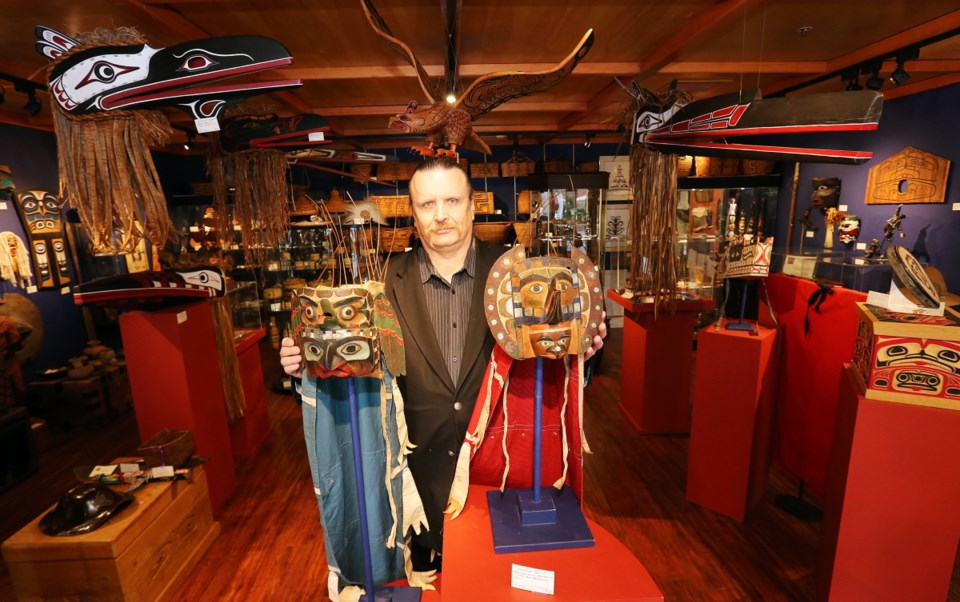Today, museums are based on the interpretation of a “story line.” A few select objects set in highly crafted sets illustrate the text posted on elaborate “didactic panels.” It wasn’t always that way. In my childhood, Toronto’s Royal Ontario Museum was a “cabinet of curiosities,” thousands of things lined up to amaze me in galleries that went on and on. I wandered and wondered, and came to my own conclusions.
Out of the Mist Gallery reminds me of one of those museums, the kind called “the nation’s attic.” Pressing the door buzzer to be let in, I found owner Tom Stark sitting there behind a desk heaped with … with what? Books and birch bark, argillite and ivory.
He invited me to sit down and I picked up the ivory. About the size of a large whale’s tooth, it seemed to have been carved as a Kuan Yin, the Chinese goddess of mercy. She was holding a curly-haired baby, and seemed more like a Virgin and Child.
As my eyes began to focus on the carving, Stark was already in mid-flight.
“She’s Japanese,” he said, “from the time when Christianity was forbidden in Japan.” He indicated that this Virgin has a wart under her chin, and long pointed fingernails on her little fingers. By then my eyes had wandered to the kaleidoscope of traditional and tribal paraphernalia that surrounded him.
Stark was backed by a wall of large and stately carrying baskets from native peoples up the coast and along the Fraser River. Smaller ones of spruce root, made with 140 knots per square inch, show scenes of the whale hunt.
On display are many horn spoons, and a chunk of weathered cedar two metres tall that was once part of a totem pole. High on the wall behind it are pieces of a handsome bent-wood box, perhaps from the Haida lands, mounted like abstract paintings. What kind of store is this?
Stark has been absorbed since childhood in the material culture of people who lived in western Canada. As a young man he worked in the basement of Capital Iron, dealing with war surplus, dismantled ships, leftovers from Chinatown and antiques from the homes of Oak Bay. His special interest has always been First Nations.
For the past 20 years, he has had his own shop named Out of the Mist, first on View Street and currently on the Douglas Street side of the Victoria Conference Centre. It’s like a museum where everything is for sale.
Stark pulled out a portfolio of a dozen large woodcut prints created by a German artist just after the First World War, showing the destruction and despair of his defeated compatriots. As I was coming to terms with them, Stark passed over a sheaf of original paintings on paper by Robert Aller of Port Alberni, an art teacher who made a positive contribution in the residential schools.
Then, from a cubbyhole nearby, Stark pulled out an oil of Trial Island on fire, painted from Beacon Hill. The artist was unknown to me, but Stark is relentless in his research and knew just when that fire had burned.
All the while, his stories poured out: about the board of directors of the Royal B.C. Museum (“don’t quote me”) and a city councillor’s reaction to his suggestion that the Maritime Museum should find a home in our cultural precinct — along with the museum.
In addition to priceless classics from the early days and contemporary versions made for the marketplace, Stark specializes in works from transitional periods, when tradition was in collision with the march of time. What is one to make of a shred of northwest coast basketry woven around a Chinese jar?
Huge “cannibal bird” masks hang from the ceiling, more treasured for their provenance than their artistry. Clearly, the culture of life of this coast is not as straightforward as the history books would lead one to believe.
Stark has placed himself at the tideline, buying and selling what he finds in the ebb and flow of cultures in transition, so he’s often criticized. How dare he buy artifacts from destitute native peoples, or make deals for the ownership of objects of mysterious provenance?
Yet Stark has been in business for years, and has rescued many extensive and precious collections that others were too timid, or too ignorant, to notice. I suspect that some of the collections that passed through his hands reached their proper perch in posterity through his act of stewardship, rather than to enrich the seller.
Consider the Chinese dance costumes of Jack and Bessie Tang. The Tangs were the public face of Chinese culture in Victoria for a long generation. When their stage clothes and props (and much else) came on the market, only Stark was seriously interested.
After being displayed at Out of the Mist, the material was largely purchased by the Royal British Columbia Museum. The restoration of a single piece from that collection, an animated lantern, became the centrepiece of a summer-long show there. Tip of the iceberg, that.
There is so much more. Out of the Mist is where it comes from.
Out of the Mist Gallery, 740 Douglas St., 250-480-4930, outofthemistgallery.com
Two weeks ago, Sandra Meigs, artist and professor at the University of Victoria, became this year’s winner of a Governor General’s Award for Visual Arts, Canada’s highest honour. And Michael Morris, an artist from Brentwood Bay (a previous winner of a Governor General’s Award), will soon be presented the Audain Prize for Lifetime Achievement in the Visual Arts.
Is it something in the water? Congratulations to these world-class artists from a little city on the edge of nowhere!
